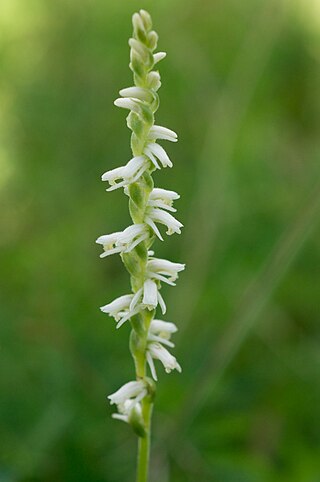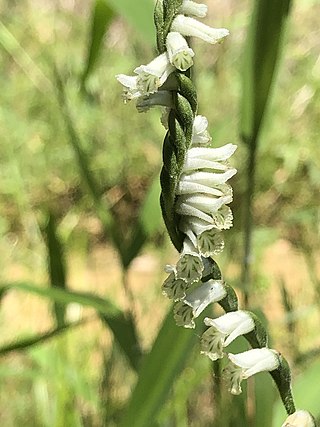
Spiranthes is a genus of orchids in the subfamily Orchidoideae. They are known commonly as ladies tresses, ladies'-tresses, or lady's tresses. The genus is distributed in the Americas, Eurasia, and Australia. The genus name Spiranthes is derived from the Greek speira ("coil") and anthos ("flower"), and was inspired by the spirally arranged inflorescence.

Spiranthes spiralis, commonly known as autumn lady's-tresses, is an orchid that grows in Europe and adjacent North Africa and Asia. It is a small grey-green plant. It forms a rosette of four to five pointed, sessile, ovate leaves about 3 cm (1.2 in) in length. In late summer an unbranched stem of about 10–15 cm (3.9–5.9 in) tall is produced with approximately four sheath-shaped leaves. The white flowers are about 5 mm (0.20 in) long and have a green spot on the lower lip. They are arranged in a helix around the upper half of the stalk. The species is listed in Appendix II of CITES as a species that is not currently threatened with extinction but that may become so. Autumn lady's-tresses are legally protected in Belgium and the Netherlands.

Gentiana andrewsii, the bottle gentian, closed gentian, or closed bottle gentian, is an herbaceous species of flowering plant in the gentian family Gentianaceae. Gentiana andrewsii is native to northeastern North America, from the Dakotas to the East Coast and through eastern Canada.

Spiranthes romanzoffiana, commonly known as hooded lady's tresses or Irish lady's-tresses, is a species of orchid. Collected by Chamisso during the Romanzov expedition it was described by him in 1828 and named for Count Nikolay Rumyantsev who financed the expedition. This orchid is native to North America, Ireland and the British Isles.

Cypripedium candidum, known as the small white lady's slipper or white lady's slipper, is a rare orchid of the genus Cypripedium. It is native to eastern North America across the northern United States and southern Canada.

Spiranthes parksii, the Navasota ladies' tresses, is a species of orchid that is endemic to Texas, United States. The flower was first discovered in 1945 and was first described by Donovan Stewart Correll in his 1950 book, Native Orchids of North America North of Mexico.

Spiranthes cernua, commonly called nodding lady's tresses, or nodding ladies' tresses, is a species of orchid occurring from Maritime Canada to the eastern and southern United States. As the common name suggests cernua means "nodding", or "bowed" in Latin.

Spiranthes ochroleuca, commonly called the yellow nodding lady's tresses, is a species of orchid occurring from southeastern Canada to the eastern United States.

Spiranthes porrifolia is a species of orchid known by the common names creamy lady's tresses and western ladies' tresses. It is native to the western United States from Washington and Idaho to southern California. It can be found in moist habitats, such as mountain meadows, swamps, fens, and riverbanks. It is a perennial herb growing from a tuberous root system, reaching a maximum height around 60 cm (24 in). The leaves are mainly located around the base of the erect stem. They are linear or lance-shaped, or sometimes nearly oval. The top of the stem is occupied by the inflorescence, a dense spiral of many flowers. Each flower is somewhat tubular, with an upper and lower lip, and cream to yellowish in color.

Spiranthes delitescens is a rare species of orchid known by the common names reclusive lady's tresses, Canelo Hills lady's tresses, and Madrean lady's tresses. It is native to Arizona in the United States, where there are only four occurrences. It is threatened by the loss and degradation of its habitat. It is a federally listed endangered species of the United States.

Spiranthes diluvialis is a rare species of orchid known as Ute lady's tresses. The species name diluvialis means "of the flood". It is native to the western United States, where there are scattered, mostly small occurrences in the states of Colorado, Idaho, Montana, Nebraska, Nevada, Utah, Washington, and Wyoming. An occurrence was recently discovered in southern British Columbia. The plant faces a number of threats to its existence. It is a federally listed threatened species of the United States.

Spiranthes odorata, marsh lady's tresses or common lady's tresses, is a species of flowering plant in the orchid family, native to the southeastern United States, from Texas eastwards and northwards to Delaware. It grows in moist, partially shaded environments with acidic or neutral soil.

Spiranthes ovalis, commonly called the October lady's tresses, is a species of orchid that is native to eastern North America.

Spiranthes tuberosa, commonly called little lady's tresses, little pearl-twist and slender ladies'-tresses is an orchid species. It is a perennial plant native to North America.

Spiranthes vernalis, commonly called the spring ladies'-tresses, is a species of orchid that is native to North America, Central America and the Bahamas.

Spiranthes lucida, the shining ladies'-tresses, is a species of orchid native to northeastern North America.

Spiranthes incurva, the Sphinx ladies' tresses, is a species of flowering plant in the family Orchidaceae. This orchid is native to the upper Midwest and Great Lakes Basin of North America. The species was originally described as Ibidium incurvumJenn. in 1906. Long treated as part of a sensu latoSpiranthes cernua, the species complex was reevaluated and Spiranthes incurva reestablished as a separate species in 2017. Spiranthes incurva is an ancient natural hybrid of S. cernuasensu stricto and S. magnicamporum.

Spiranthes praecox, the grass leaved ladies' tresses, green-vein ladies'-tresses or sometimes giant ladies' tresses is a terrestrial orchid endemic to the United States, growing on the eastern coastal plains and around the Gulf Coast.
Spiranthes graminea or the Canelo lady's tresses is a species of orchid found in Mexico and Central America.


















